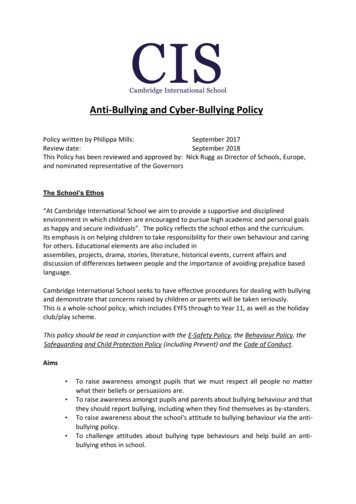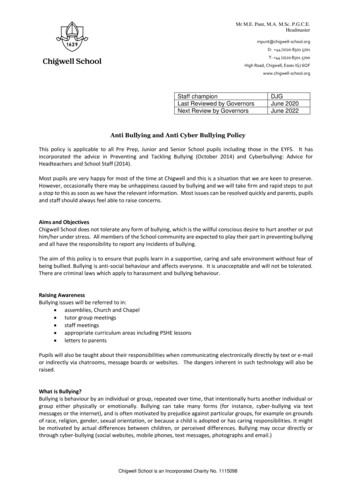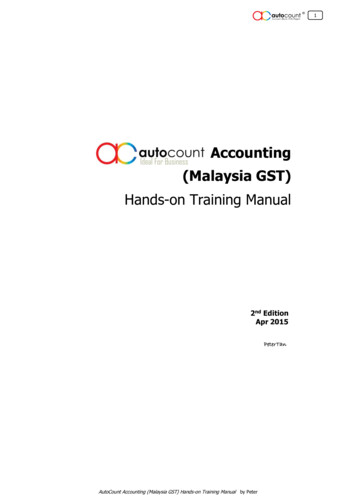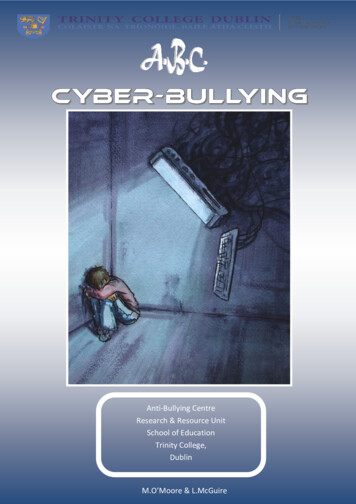
Transcription
Proceedings of SOCIOINT 2017- 4th International Conference on Education, Social Sciences and Humanities10-12 July 2017- Dubai, UAESCHOOL BULLYING IN MALAYSIA:CAUSE, EFFECT AND A POSSIBLE SOLUTIONMuzaffar Syah MallowDr., Senior Lecturer, Faculty of Syariah & Law, Universiti Sains Islam Malaysia (USIM)Bandar Baru Nilai, Negeri Sembilan Darul Khusus, MalaysiaEmail: muzaffarsyah.mallow@yahoo.comAbstractThe issue concerning school bullying cannot simply be ignore any longer as the negative impacts it couldgenerate to everybody especially to the victim in particular, the school as well as to the country educationreputation in the long term. Similar attention should also be given to the bullier. If no action is taken at earlystage, the bullier will eventually maintain such behavior into adulthood and continue to become active bullier inthe society. There also study which indicate that such unstoppable behavior will also expose the bullier to getinvolve with other kinds of criminal activities. Taking into account all the possible negative impacts from the act ofbullying in school, the issue has been taken seriously by many factions in the country which includes thegovernment, the non - government organization (NGO), academician, and social activists in the recent years.According to the statistic released by the country Ministry of Education, in 2015 alone there have been 3,011cases being reported for school bullying in the country. Due to this staggering statistic number, the Ministry ofEducation along with other entities in the country has started to meet and discuss on the possible solution to theproblem. Among the latest proposal that being put forward to deal with the problem is to suspend student whoinvolve in act of bullying in school for certain period of time. The latest suggestion so far has been welcome byall as this will send strong signal to bullier over the government serious effort to combat with the ongoingproblem. Being said so, the latest proposal needs to be further discuss and examine as it involve the future ofthe bullier themselves which after all is also a minor themselves. Though assurance has been given by therelevant ministry that the suspension period come with other activities and programs which would benefits thebullier themselves, more efforts need to be taken to combat with the issue as the ministry themselves admit theissue has become serious in our country. If no concrete action being taken now, it would harm not only thevictim’s physically and psychologically but it will also affect the reputation of the country education system andthe employment prospect in long term. As such, it is the object of the paper to examine further the issueconcerning school bullying in general, types of bullying which can take place within school, the impacts which itwould generate to the victim as well as to the bullier themselves, and find any possible solutions to the deal withthe current problem without jeopardizing the future of all parties involved in such crime.Keywords: School, Bullying, Causes, Effects & SolutionsISBN: 978-605-82433-1-6154
Proceedings of SOCIOINT 2017- 4th International Conference on Education, Social Sciences and Humanities10-12 July 2017- Dubai, UAE1. INTRODUCTIONIts the fact that the issue concerning school bullying is not the problem faced by Malaysia alone, but which also aproblem face by many countries across all over the world. No country can claim that their school is 100%immune from such problem. Its common for child to develop and have some sort of attitude. Some attitude canbe good and would benefits the child themselves and others but some attitude can be bothersome and wouldcreate problem not only towards the individual children themselves but also towards other surrounding peoplelike bullying. (Abdul Ghani Abdullah and Abdul Rahman Abdul Rashid, 2009, p. 6). Malaysia has counter with theproblem concerning bullying in school for the last many years. According to the statistic released by theMalaysian Education Ministry in 2016, there seem a worrying trend on the number of reported cases on schoolbullying in the country from 2008 until 2015. In 2008, the total number of reported cases on school bullying in thecountry is around 3,107 cases, in 2009, the number has go down to 2,889 cases, in 2010, the number has godown again to 2,617 cases, however in 2012 the number has jump up drastically to 4,159 cases, in 2013 thenumber is around 4,120 cases, in 2014 the number has go down to 2,906 cases and in 2015 the number hasjump up again to 3,011 cases. (Utusan Malaysia, 22 October 2016). Before commenting on the given statistic, itis crucial for us to remember that due to the sensitive nature of the case surrounding the issue concerningschool bullying especially the humiliating effect it could bring in term of psychologically and mentally for thevictim pupil there are many bullying cases could have not been properly reported at all. As such, it is believed bymany that there could be more cases on the matter which are not being properly reported and expose to thegeneral public and thus will remain silent keep by the victim themselves.Below are few examples of the highlighted cases on school bullying which has happen in the country for the lastthree years and which had received wide attention through local media and have generate a public outcry for itssolution. In February 13, 2015, a form three, secondary school female student claimed to be traumatised afterbeing physically bullied by senior students at a school in Pokok Sena, Kedah. In the incident which happen at2.15 pm, the victim Nur Fatihah Md Lazim, 15 years old, was at the motorcycle parking lot and about to headhome with her cousin when a group of 10 female students allegedly confronted them. One of them asked thevictim the same question repeatedly but because she did not answer, she was slapped on the left cheek by asenior student while the rest of them observed. The victim tried to retaliated by slapping the perpetrator back butmissed. After that the perpetrator pulled her scarf and hair until she fell. The victim, Nur Fatihah said the incidentstemmed from a misunderstanding happen between two groups at her school; one group had mentioned hername, causing the other group to come after her. The matter was later been reported to the the nearby policestation and the case was filed under Section 323 of the Malaysian Penal Code (Act 574) for voluntarily causinggrievous hurt. (MyNewsHub, February 13, 2015).On 23 March 2016, a year two, primary school pupil in Klang, Selangor snipped off the tip of his own tongue witha pair of scissors after he was being bullied into doing so by five nine year old boys. According to South KlangOCPD Asst Comm Azman Abdul Razak, the incident happened in a classroom at SRK Batu Unjur, Bukit Tinggi.According to media, there were no other students or a teacher in the classroom when the incident happened.The boy's mother, a 28 year old cashier, lodged a police report the following day at the South Klang districtpolice headquarters. According to the report, the mother received a call from the school regarding the incident atabout 6pm on the day of the incident. Both the mother and a teacher brought the boy to the Hospital TengkuAmpuan Rahimah where he related what had happened. He narrated how the five boys told him to cut his owntongue if he did not want them to punch him up in the face. Frightened, the boy did as he was told. The mother'spolice report also stated that the boy had complained several times that he was being bullied by the group ofboys. The victim boy received outpatient treatment at the nearby hospital and that the incident are currentlybeing investigated under Section 506 of the Malaysian Penal Code (Act 574) for criminal intimidation.(The StarOnline, 27 March 2016).In 20 February 2017, a 14 year old secondary school male pupil was left hospitalised after being beaten up byfour of his senior in a school in Sungai Petani, Kedah. According to media report, the victim, sustained serioushead and bodily injuries. He is being warded at the Sultanah Bahiyah Hospital’s intensive care unit in Alor Star.Kuala Muda Police Chief Md Zukir Md Isa said police believed the incident arose after the victim had apparentlypulled the arm of a classmate. The classmate’s brother is said to have later attacked the victim with three others.Zukir said four boys had been detained for questioning and are being investigated under Section 325 of theMalaysian Penal Code (Act 574) for voluntarily causing grievous hurt. The victim’s father has lodged a reportISBN: 978-605-82433-1-6155
Proceedings of SOCIOINT 2017- 4th International Conference on Education, Social Sciences and Humanities10-12 July 2017- Dubai, UAEwith the police. According to media report, the father claimed his son was asked by his teacher to call theattacker’s sibling into the classroom but this act was misunderstood by the attacker. He said the boy complainedof headaches after school on the day of the attack and started vomiting on the way to hospital. Hospital scanstaken later revealed there was bleeding in the brain. (Free Malaysia Today, 25 February 2017).All the highlighted cases given above are only few as compared to many reported and unreported cases beenhighlighted in the country recently. As from above cases, it is also equally important for us to examine thedefinition of the word bullying itself and variety of forms it might take place. When it comes to the act of bullying,there is no single universal legal definition on it. Bullying can be define as a repetitive behaviour which isintended to hurt someone either by way of emotionally or physically, and is often aimed at certain individualbecause of many reasons like due to religion, race, gender or sexual orientation or any other aspect such asbeing different from other people, appearance basis or even disability of the victim. (Pete Sanders, 1995, p. 18)Various forms of bullying can happen to student in school similar to young adult in university and full adult at aworkplace like social and emotional bullying which includes excluding someone out on purpose, encouragingothers not to be friends with them, spreading gossip or rumors, humiliating someone in front of others and others.With the creation of new communication technologies though WiFi and internet like Facebook, Twitter,WhatsApp, Instagrams, and others, such act can also take online in the form of cyberbullying which usuallyhappen on social networking sites, messaging apps, gaming sites and even within social chat rooms. The act ofbullying can also become verbal which can includes teasing, making derogatory remarks about appearance,taunting or irritate someone, making threats and using insults as a way of humiliating the other person. (KeithSullivan, Mark Cleary and Ginny Sullivan, 2004, pp. 3 - 4).The act of bullying can also become sexual in nature like sexualised name calling, sharing of intimate images,texts and videos, inappropriate sexual remarks and in its most extreme or highest form cases can also includesexual harassment, molestation, sexual assault or even rape. Not to forget physical abused as well. This ishappen when the victim themselves been physically hurts by the perpetrator. This can occur by way of pushing,punching, kicking, biting, scratching, spitting and any other form of physical violence and abuses. (KamarizanHamzah, 2007, p. 16 - 17)2. CAUSE OF SCHOOL BULLYINGIt is very difficult for us to determine the exact cause for school bullying and why this ill behaviour happens?Various factors can be considered for the possible cause for school bullying. As for the perpetrator, the possiblecause for them to get involved in such ill behavior might simply because they feeling powerless in their own livesas such by getting involve with the act of bullying, it can be regarded as a way they can claim a sort of power intheir own lives namely by way of victimising another or putting other people in misery. (Kamarizan Hamzah,2007, p. 15). The perpetrator might also be the victim themselves in the first place as they also might besubjected to bullied by someone more powerful than themselves. As such, to channel their anger for beingsubjected to bullied, they simply repeat those ill behavior towards other who they see weaker than him or herand easy for them to perform such act. The perpetrator might also do the act out of jealously or frustration andthey have no idea how to channel those feeling accordingly besides bullying others. (Kamarizan Hamzah, 2007,p. 6)In some cases a perpetrator may bully others because there is an aspect of a person’s personality that theydon’t understand or don’t agree with. They may also have a prejudice against a person’s race, religion, gender oreven sexual orientation, and in many instances they may even think that targeting a person whom they see asexuding wrong behaviour as a good thing. This lack of empathy may be learned at home, if the bully’s parents ofrelatives voice sexist or racist attitudes, for example, the bully could pick up this behaviour. It is also important forus to know that some perpertrator would never think of themselves as bullies. They think that all they are doingis teasing a bit, and may even be trying to communicate or even befriend the person they are bullying. Theseissue lead them to have trouble of communicating in a healthy and normal way and instead turn to insults oreven physical violence as a way for them to communicate with others or express themselves.The family situation of the perpetrator can also be a contributing factor for the such ill behavior to take place.Lack of emotional support, authoritarian parenting, divorces, domestic violence and poor parentalcommunication are all potential factors in the lives of bullies. (Joshua Miller, Irene R. Martin, and GeraldSchamess, 2003, pp 3 - 85). According to Dr. Nerissa Bauer, a specialize expert on the issue:ISBN: 978-605-82433-1-6156
Proceedings of SOCIOINT 2017- 4th International Conference on Education, Social Sciences and Humanities10-12 July 2017- Dubai, UAE“Parents are very powerful role models and children will mimic the behavior ofparents, wanting to be like them. They may believe violence is OK and they canuse it with peers. After all, they may think, ‘If Daddy can do this, perhaps I can hitthis kid to get my way.’ When parents engage in violence, children may assumeviolence is the right way to do things”.Based on this simple reason, the perpetrator could simply imitate what they witness at home at put into practicethose abuse and violence activities which they have seen and learned at home towards others in school. (JoelSchwarz, 2006)Beside focusing on the perpetrator and their family background it is also important for us to look into the possibleschool environment itself. Some schools are not conducive enough to deal or cope with the problem in the firstplace. This can be seen in the current scenario especially in the public schools in the country where teacher aresometimes being given which huge number of pupil within a classroom (From 35 - 50 students) for them to be incharge with. As such, it would be very difficult for them to look after and focus the matter in detail. Not tomentioned, sometimes there is only few number of disciplinary teacher and counselor in charge in a particularschool to deal with the problem. The issue also might not be treated serious enough by the school managementas the topic sometimes being highlighted once a year normally during the beginning of school session as such,the students might interpret this as sometimes which is not serious for them to be bother with.There might also be lack of cooperation between school management with the students parent or guardian aswell as with the outside expert or the non - governmental bodies that have done deep study on the issue.Without having such cooperation, it would be very difficult for school management to fully understanding theproblem they face and the school might not having the correct and update information’s to deal with the issuemore effectively and efficiently. (Further reference can be made to Walter B. Roberts, 2008, pp. 17 - 20 and HillM.Walker, Geoff Colvin and Elizabeth Ramsey, 1995, pp. 269 - 302).Currently, there is also no comprehensive rules and regulations on the issue. The issue is normally been viewunder the general heading on students misbehavior or disciplinary problem. Any serious cases could normallybeen dealt under the country existing law which being use for adult like the Malaysian Penal Code (Act 574). Assuch, it is important for the country to develop its own specif rules on the issue so that the matter can be identifyclearly and be tackle more efficiently and effectively by taking into account the nature of the underage pupilsinvolve. Having specific law on the issue can also been seen as a positive step as it would also bring a clearsignal and reminder to everybody in the country that the issue will not be tolerated in any circumstances and theperpetrator will be brought to justice. (Roger Slee, 1995, pp. 33 - 61).4. EFFECT OF SCHOOL BULLYINGThough it is hard to identify the exact cause of school bullying the country, it is not so as to identify the effects itcould bring not only towards the victim but to others. To begin with, a victim to bully, in the short term, may feelsad, depressed, remorse, anxious, angry, could even potentially developed excessive stress, feel helpless, feelas though their life has fallen apart, have a significant drop in school performance especially in their academicperformance, or may even in the worst case scenario could potentially lead to suicide. (Further reference on thematter can be made to Azizi Yahaya, Sharin Hashim, Yusof Boon, and Zurhana Muhammad, 2008. pp 76 - 78 &Noran Fauziah Yaakub, 2006, pp. 80 - 88). If the bullying act continue to happen, in the long term, the victimmay feel insecure, begin to develop lack of trust toward other people, exhibit extreme sensitivity, or in a moreserious case start to develop a mental illness such as psychopathy, avoidant personality disorder or PTSD. Thevictim may also developed a desire of vengeance, sometimes leading them to torment others in return andbecome the potential perpetrator themselves in the distant future. (Mark Dombeck, 2016, Updated).The effect of bullying is not limited to victim themselves, it could also effect other pupil who seen the act. Suchpeople we can refer to as a bystander. This can includes the victim classmate, friend, peers and others.According to a study, being a bystander can produce similar feelings of anger, fear, guilt, and sadness like thevictim themselves. Bystanders who witness repeated victimization of their own classmate, friend or peers canalso experience negative effects similar to the victimized pupil themselves. (Hirsch, Lee; Lowen, Cynthia; andSantorelli, Dina, 2012).The effect of bullying can also effect the perpetrator themselves. While most bullies, in the long term, grow to beISBN: 978-605-82433-1-6157
Proceedings of SOCIOINT 2017- 4th International Conference on Education, Social Sciences and Humanities10-12 July 2017- Dubai, UAEemotionally functional adults, according to study many have an increased risk of developing anti-socialpersonality disorder which sometimes being linked with increased risk of committing criminal acts. (Pappas,Stephanie, 20 February 2013).Bullying will also in the long run effect the country education quality and the society. The unstoppable act ofbullying may make every effected individual afraid to go to school. When this happen, it will interfere with theirability to focus in their study and concentrate in the classroom learning or participate in any of the schoolactivities and programs. The serious outcome to the problem include missing classes, continuous absentees oreven dropping out of school system entirely. If the problem goes on without control and unchecked, this in turnwill certainly has an adverse impact on the future on the quality of the country education institution andemployment prospects of its peoples. (UNESCO, pp. 17, 29 & 31).5. POSSIBLE SOLUTIONKnowing the serious potential harm from the effect of school bullying, it is very important for all relevant partiesand agencies in the country to take immediate and concrete action to deal with the problem. As mentionedearlier, if no concrete action being taken now, it would harm not only the victim’s physically and psychologicallybut it will also affect the reputation of our education system as well as the society itself in the long term. If wetake the matter so lightly, it will certainly send a wrong signal to the bullies to commit the act boldly withouthaving any regret and understand the consequence of their ill action towards others and towards themselves.There are many steps which can be taken to put an end to school bully cases one of it is by having effectivelegislation in place. This can be done by amending the existing Malaysian Education Act 1996 (Act 550) orcreating a new specific law which address the issue of bullying in our school. We can learn a lot from what hadbeen done in the United Kingdom’s where by virtue of their Section 89 of the Education and Inspections Act2006 which provides for an anti-bullying policy to be made for all state schools and to be made available toparents as well. It has been widely believe that creating and developing a strong and proper policy againstbullying in schools would create high awareness among young pupils at early age not to get involve with the act.Through this policy, it will also establish a climate in which bullying is not tolerable and acceptable. Similarlything has been implement in the United States of America, where all 50 states in the US already have their ownanti-bullying laws. Some of the written policies in the country even require disciplinary procedures to be madespecifically to deal with bullying incident while others mandate that schools track and report for every bullyingincident that occur. A growing number of states in the US also currently require schools to employ someonespecially trained in anti-bullying education. Having specific and comprehensive legislation on the issue wouldallow the concern parties to deal with problem properly.Besides having effective legislation, it is also important for everyone in the community to work together to send aunified message against any act of bullying. This can be simply done by launching an awareness campaigns,programs or activities consistently every year to make the objectives known to the pupils, school, parents, andcommunity members on the issue. Its also time for our school management to make an active initiative andhaving consistent cooperation with all the experts and non - governmental bodies in the country to combat theproblem.Teachers and parents must work closer to deal with the issue openly and continue to find ways to deal with the it.Both parties can fully utilise the existing Parent Teacher Association (PTA) platform to communicate each otherto find ways to deal with the matter. It is crucial to note that without having good and continuous support fromeveryone, it would be very difficult to deal with the ongoing problem efficiently and effectively.ACKNOWLEDGEMENTThe researcher would also like to acknowledge Muhammad Azhar Zakaria, Final Year Undergraduate Student,Bachelor of Syariah & Law (SMSU), Faculty of Syariah & Law, Universiti Sains Islam Malaysia (USIM) for all theassistance and contribution given for the research paper.ISBN: 978-605-82433-1-6158
Proceedings of SOCIOINT 2017- 4th International Conference on Education, Social Sciences and Humanities10-12 July 2017- Dubai, UAEREFERENCE LISTAbdul Ghani Abdullah and Abdul Rahman Abdul Aziz. (2009). Mengurus Tingkah Laku Pelajar. Kuala Lumpur:PTS Professional Publishing Sdn. Bhd.Azizi Yahaya, Sharin Hashim, Yusof Boon, and Zurhana Muhammad. (2008). Tip Menangani Buli Di Sekolah.Kuala Lumpur: PTS Professional Publishing Sdn. Bhd.“Buli Tiada Berkesudahan”, Laporan Khas Sabtu, Utusan Malaysia (Local Newspaper), 22 October 2016, Page22.“FormThree Student Claims Trauma After Senior’s Bully”, 15,Hill M.Walker, Geoff Colvin and Elizebeth Ramsey. (1995). Antisocial Behavior in School: Strategies and BestPractices. United States of America: Brooks/Cole Publishing Company.Hirsch, Lee; Lowen, Cynthia; and Santorelli, Dina (2012). Bully: An action plan for teachers and parents tocombat the bullying crisis”. New York: Weinstein Books.Joel Schwarz, “Violence in the home leads to higher rates of childhood bullying”, 12 September odbullying/Joshua Miller, Irene R. Martin, and Gerald Schamess. (2003). School Violence and Children in Crisis:Community and School Interventions for Social Workers and Counselors. Denver: Love PublishingCompany.Kamarizan Hamzah. (2007). Elakkan Diri Daripada Menjadi Mangsa Buli. Kuala Lumpur: Rimbunan Ilmu Sdn.Bhd.Keith Sullivan, Mark Cleary, and Ginny Sullivan. (2004). Bullying in Secondary Schools: What it looks like andhow to manage it. United Kingdom: Cromwell Press Limited.MarkDombeck, “The Long Term Effects of Bullying”, -effects-of-bullying/September2016(Updated),Noran Fauziah Yaakub. (2006). Buli Di Sekolah: Apa yang kita tahu dan apa yang boleh kita buat. KualaLumpur: Sutrapadu (M) Sdn. Bhd.Pappas, Stephanie (20 February 2013). "Long-Term Effects Of Bullying: Pain Lasts Into Adulthood (STUDY)".Huffington Post. Retrieved 15 April 2014.Pete Senders (Translated by Zaridah Mat). (1995). Apakah yang anda tahu tentang membuli. Petaling Jaya: FloEnterprise Sdn. /2016,Roger Slee. (1995). Changing Theories and Practices of Discipline. London: The Falmer Press.“Student to face 6 months’ suspension if guilty of bullying”, Free Malaysia Today, 25 February -ifguilty-of-bullying/The United Nations Educational, Scientific and Cultural Organization (UNESCO) (2017). School Violence andBullying: Global Status Report, Paris, UNESCO. pp. 17, 29, 31.Walter B. Roberts Jr. (2008). First Edition. Working with Parents of Bullies and Victims. California: Corwin Press.ISBN: 978-605-82433-1-6159
of headaches after school on the day of the attack and started vomiting on the way to hospital. Hospital scans taken later revealed there was bleeding in the brain. (Free Malaysia Today, 25 February 2017). All the highlighted cases given above are only few as compared to many reported and unreported cases been highlighted in the country recently.










